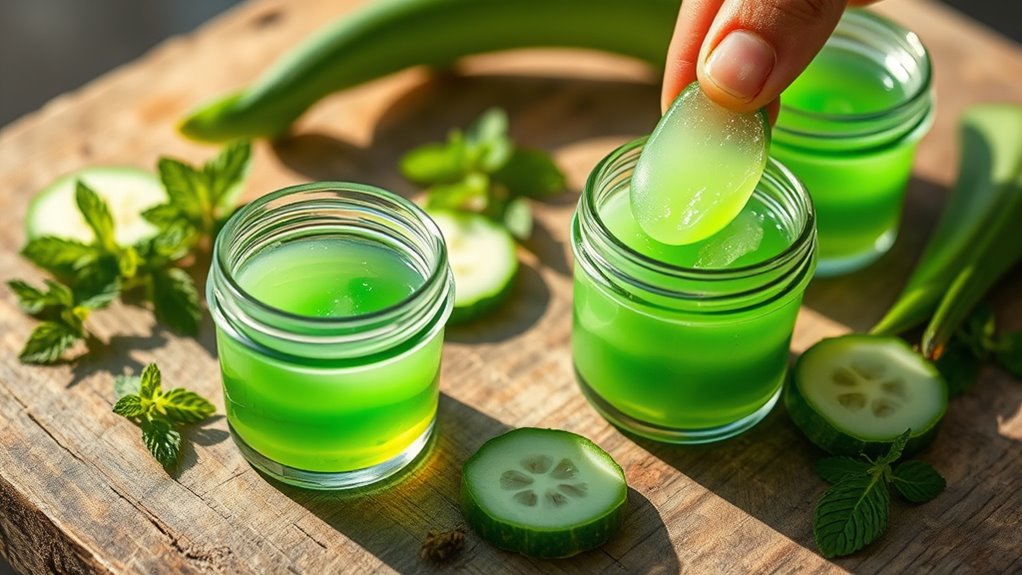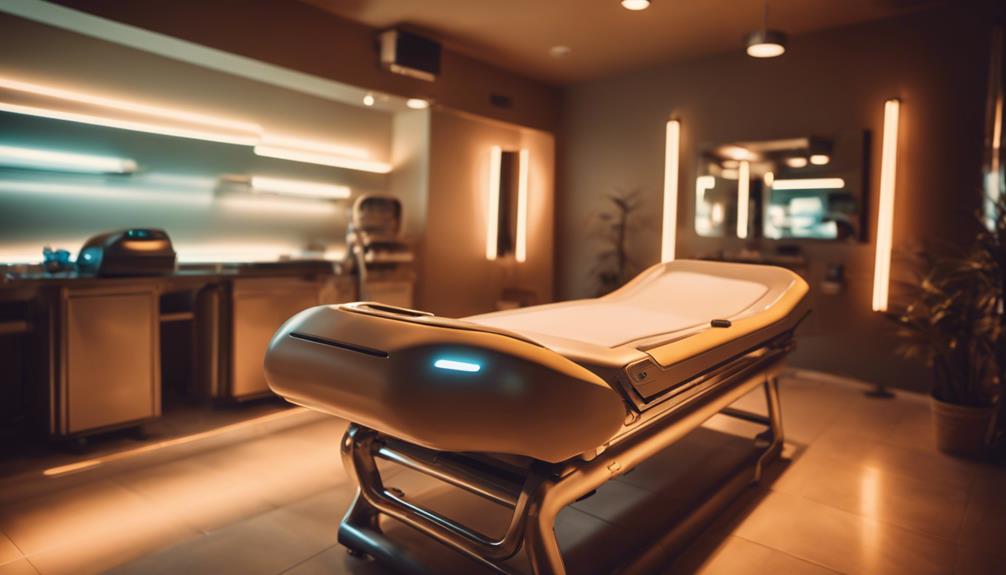To create DIY herbal aloe gels for post-sun care, start by selecting fresh, high-quality aloe vera leaves, carefully extracting the clear gel while avoiding the yellow latex. Incorporate soothing herbs like chamomile, calendula, or lavender, and add nourishing ingredients like rosehip oil or green tea. Use sterilized equipment and store your gel in airtight containers in a cool, dark place to preserve its benefits. If you continue, you’ll discover detailed steps for making and customizing your perfect herbal aloe gel.
Key Takeaways
- Select fresh, thick aloe vera leaves and carefully extract pure gel to ensure maximum soothing and healing properties.
- Incorporate calming herbs like chamomile or lavender and nourishing extracts such as rosehip oil for enhanced post-sun skin recovery.
- Use sterilized tools and airtight containers to preserve gel freshness and prevent contamination during preparation and storage.
- Add natural preservatives like vitamin E to extend shelf life and maintain the efficacy of your herbal aloe gel.
- Store your DIY herbal aloe gel in a cool, dark place or refrigerator, and label with creation date for optimal freshness.
Choosing the Right Aloe Vera for Your Gel

When selecting aloe vera for your homemade gel, it is vital to choose high-quality, fresh leaves or pure aloe vera gel. Look for thick, firm leaves with a vibrant green color, free from blemishes or discoloration. If you opt for fresh leaves, harvest them from a mature plant, ideally from the lower part of the stem, where the gel is most concentrated. Avoid leaves that are wilted or have brown spots. For store-bought gel, ensure it’s 100% pure aloe vera without added chemicals or preservatives. Reading labels carefully helps you avoid fillers that can irritate your skin or diminish the gel’s soothing properties. High-quality aloe ensures your homemade gel is effective, pure, and gentle, perfect for post-sun skin care. Additionally, selecting aloe vera with proper filtration can help ensure the removal of contaminants and enhance the gel’s purity. Incorporating quality sourcing practices supports overall product effectiveness and safety. Moreover, choosing aloe vera from reputable suppliers may guarantee the optimal potency of the gel, ensuring maximum skin benefits.
Selecting Herbal Additives for Skin Soothing
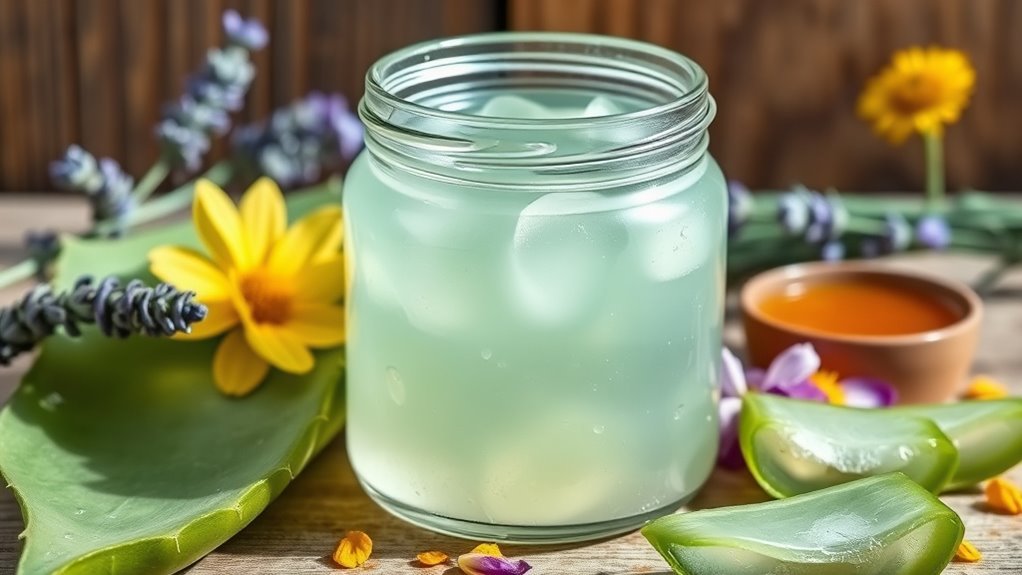
When choosing herbal additives for your aloe gel, focus on calming ingredients like chamomile or lavender to soothe irritated skin. Nourishing options such as calendula or green tea can enhance healing and hydration. Selecting the right combination helps create a gentle, effective remedy tailored to your skin’s needs. Incorporating ingredients with exfoliating properties can also support skin renewal and improve overall texture. Using herbal extracts that are compatible with protective styling can further enhance your post-sun skincare routine. Additionally, considering how automation in business streamlines production processes can help you develop more efficient DIY formulations. For instance, understanding the cost variations of different herbal additives can assist in budget planning and product consistency. Recognizing the health benefits of certain herbs can further optimize your formulation for skin recovery and overall wellness.
Calming Herbal Ingredients
Choosing the right herbal additives can substantially enhance your aloe gel’s soothing properties. Look for herbs known for their calming effects to help reduce redness and irritation after sun exposure. Incorporate ingredients like chamomile, which contains anti-inflammatory compounds that calm sensitive skin. Lavender is another excellent option, offering natural relaxation and soothing benefits while helping to reduce inflammation. Calendula flowers are also beneficial, as they promote healing and soothe irritated skin. When selecting herbal ingredients, consider their potency and how well they blend with aloe. Use fresh or dried herbs, and always test small amounts first to avoid possible allergic reactions. Additionally, understanding UV exposure risks can help you better tailor your post-sun care routine for optimal skin recovery. Recognizing the importance of color accuracy in home projectors can inspire you to choose calming herbal blends that promote relaxation and skin healing. Incorporating safe herbal choices ensures your post-sun aloe gel delivers effective relief and a gentle touch for sensitive skin. Furthermore, being aware of ethical hacking concepts like testing and vulnerability assessment can inspire you to experiment with different herbal combinations safely. For example, carefully evaluating herbal potency can help prevent adverse reactions and maximize soothing effects.
Skin Nourishing Additions
Selecting herbal additives that nourish your skin can substantially boost your aloe gel’s overall soothing benefits. Ingredients like calendula, chamomile, and lavender are excellent choices because they promote healing and reduce irritation. Calendula contains antioxidants that help repair damaged skin, while chamomile offers anti-inflammatory properties to calm redness. Lavender not only soothes but also has antimicrobial effects, preventing infection. You might also consider adding rosehip oil for its rich vitamins A and C, which support skin regeneration. When choosing herbal additives, verify they’re pure and suitable for sensitive skin. Incorporating Herbal infusion techniques can enhance the potency of your herbal additions. Additionally, selecting reputable suppliers ensures the purity and effectiveness of your herbs, aligning with best practices in payment processing for secure transactions. Employing spiritual energy practices like intention setting during herbal preparation can further amplify your healing intentions. Using natural and organic ingredients helps ensure your herbal aloe gel remains gentle and effective, especially for post-sun skin recovery. Incorporating herbs with anti-inflammatory properties can further soothe irritated skin and accelerate healing. These nourishing additions enhance post-sun recovery, leaving your skin feeling calm, replenished, and healthier.
Gathering Essential Supplies and Equipment
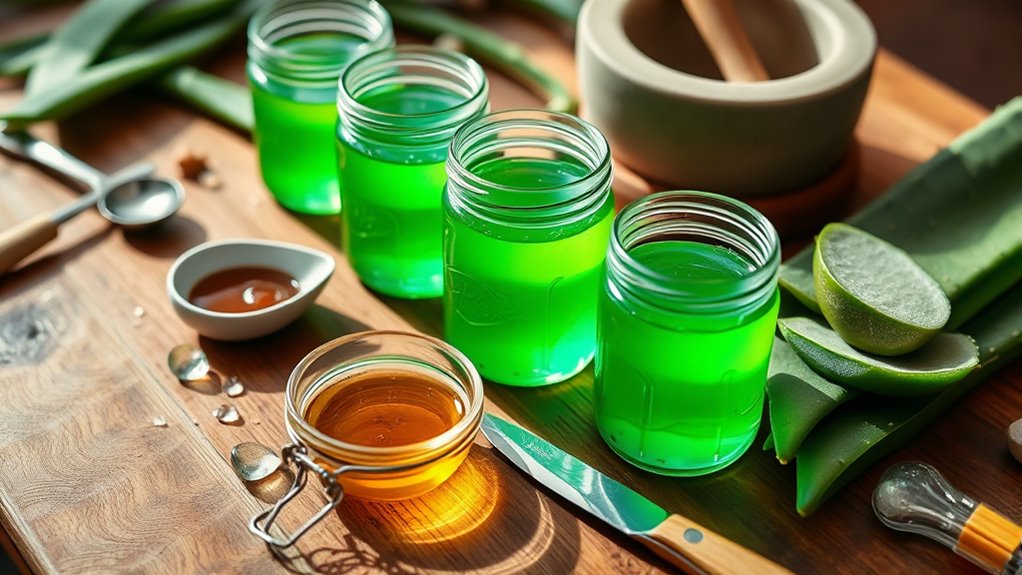
To create effective herbal aloe gels, you need to gather all the essential supplies and equipment beforehand. Having everything ready guarantees a smooth process and better results. You’ll want clean, sterilized tools to prevent contamination and preserve the gel’s freshness. A high-quality blender or hand mixer will help you thoroughly combine ingredients and achieve a smooth consistency. Additionally, prepare your containers—preferably glass jars or bottles—to store the finished gel safely. Using self watering plant pots in your gardening setup can help maintain consistent moisture for the plants used in your herbal infusion, ensuring they stay healthy and vibrant throughout the process. Ensuring the safety of your tools and workspace is also crucial, especially considering AI security concerns related to digital data handling. Proper sanitation and secure handling are essential for maintaining product quality and preventing microbial growth. Incorporating proper sterilization techniques further safeguards your herbal preparations from contamination.
Preparing Fresh Aloe Vera Gel From the Plant
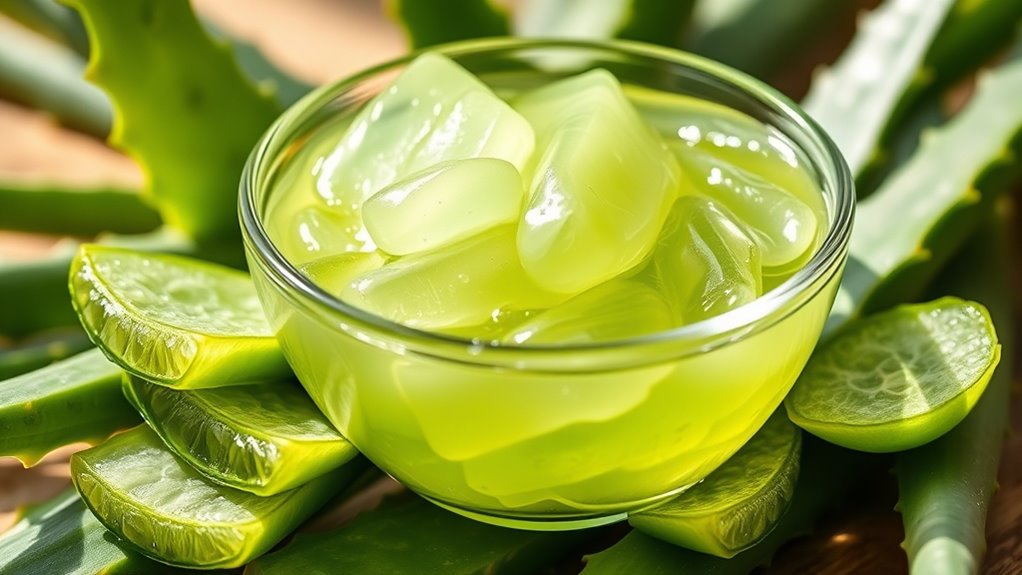
If you have fresh aloe vera leaves, start by rinsing them thoroughly under cold water to remove dirt and debris. Use a sharp knife to cut off the base and the spiky edges along both sides of the leaf. Next, slice the leaf lengthwise to expose the clear gel inside. Gently peel back the skin with your fingers or a spoon, being careful not to pierce the gel. Collect the translucent aloe vera gel in a clean bowl. Avoid touching the yellowish latex, called aloin, as it can be irritating. Once gathered, you can proceed to prepare the gel for your post-sun care products. Handling the fresh gel carefully guarantees you retain its soothing properties and avoid unnecessary irritation. Proper handling techniques are essential to preserve the gel’s natural benefits and ensure safety during application. Additionally, using quality tools can help maintain the integrity of the gel during processing. To further protect your health, it’s advisable to be aware of potential state tax implications for IRA withdrawals if you plan to use financial resources for your DIY projects, as understanding these can help you plan your expenses more effectively.
Creating a Basic Aloe Vera Gel Base
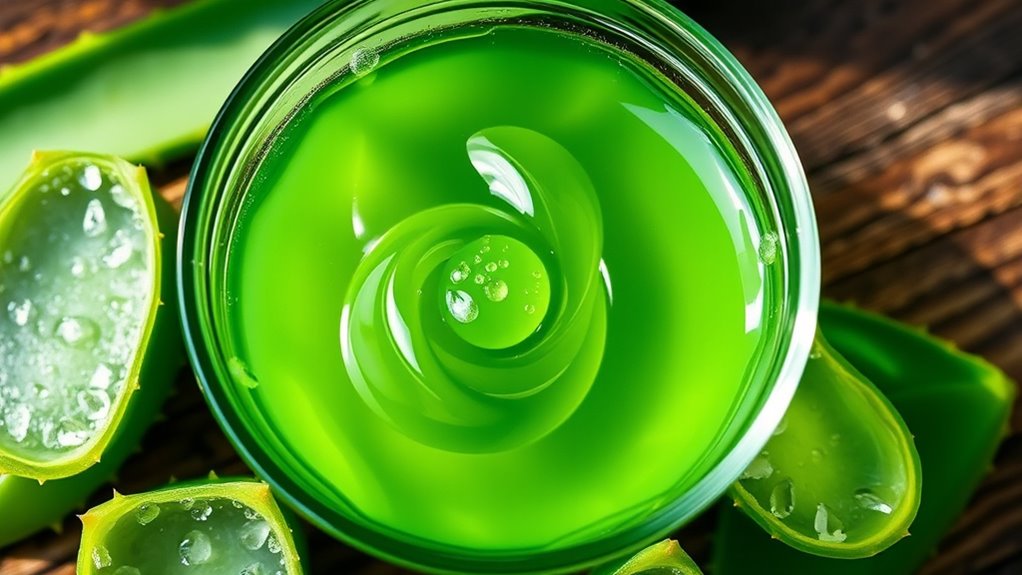
To create a simple aloe vera gel base, you need to start with high-quality leaves and choose an effective extraction method. Fresh, healthy leaves produce the best gel, so inspect them carefully before harvesting. Once you’ve selected your leaves, you can extract the gel using gentle techniques that preserve its natural properties.
Aloe Vera Extraction Methods
Creating a basic aloe vera gel base starts with carefully extracting the gel from fresh aloe leaves. First, select thick, healthy leaves and wash them thoroughly. Use a sharp knife to cut the edges and peel away the outer skin, revealing the clear gel inside. Scoop out the gel with a spoon or spatula, avoiding the yellow latex, which can be irritating. To preserve enzymes and nutrients, process the gel promptly or store it in an airtight container in the refrigerator. Proper extraction ensures your gel is pure, effective, and free from contaminants.
- *Choose mature, healthy leaves for maximum gel quality.*
- *Avoid yellow latex, as it can cause skin irritation.*
- *Process or refrigerate quickly to maintain freshness and potency.*
Choosing Quality Aloe Leaves
Choosing high-quality aloe leaves is essential for making effective and pure gel. Look for thick, plump leaves with vibrant green color and no signs of browning or damage. Mature leaves, usually around 8 to 12 inches long, contain the highest concentration of beneficial compounds. Avoid leaves that are wilted, dried out, or have dark spots, as these indicate age or poor health. Freshly harvested leaves yield the best gel, so select leaves soon after harvesting if possible. If buying from a store, choose organic or reputable brands that prioritize quality. Properly selecting your aloe leaves ensures your gel will be potent, clear, and free of contaminants, providing the best soothing effects for your post-sun skin care routine.
Incorporating Herbal Infusions and Extracts
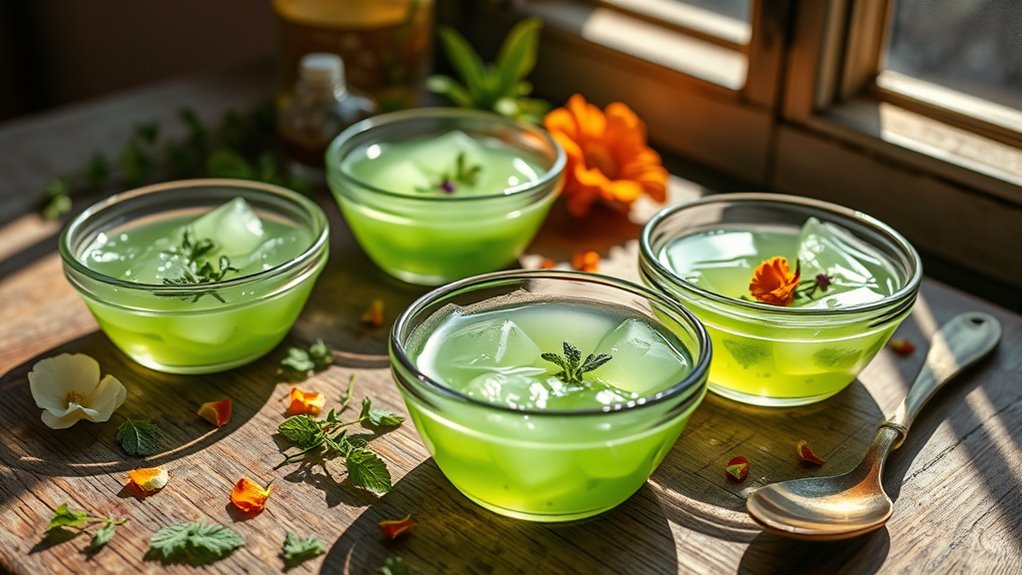
Incorporating herbal infusions and extracts into your aloe gel enhances its soothing and healing properties markedly. By adding these natural ingredients, you target specific skin concerns and boost your gel’s effectiveness. Use dried herbs like chamomile or calendula by steeping them in hot water to create infusions. Extracts such as aloe vera, witch hazel, or tea tree oil can be directly blended into your gel for added benefits. Remember, the quality and freshness of your herbs influence the final product’s potency. Incorporate small amounts and test for sensitivities. This approach allows you to customize your gel, making it more tailored to your skin’s needs.
- Personalize for your skin type and sensitivities
- Maximize natural healing and anti-inflammatory effects
- Create a more potent, customized post-sun relief remedy
Enhancing Your Gel With Additional Skin-Nourishing Ingredients
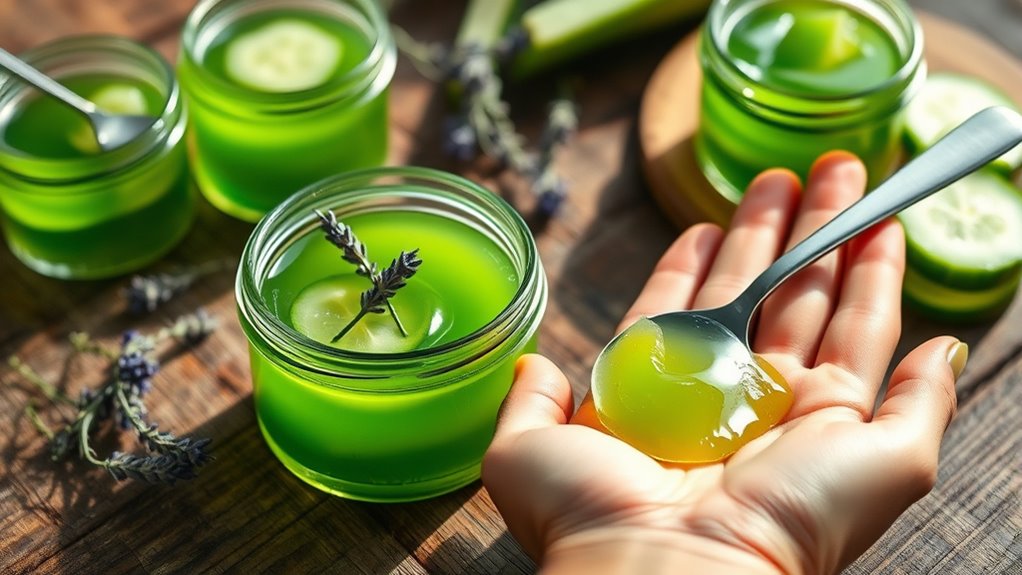
Have you considered adding other nourishing ingredients to your aloe gel to boost its benefits? Ingredients like vitamin E oil can enhance healing and provide antioxidant protection, while jojoba or argan oil add moisture without feeling greasy. You might also include soothing options like cucumber extract or chamomile for extra calmness, especially after sun exposure. A few drops of essential oils such as lavender or tea tree can offer antiseptic properties and a pleasant scent. When adding these ingredients, start with small amounts and test your gel on a patch of skin to avoid irritation. Incorporating these extra components allows you to customize your gel, making it more effective and tailored to your skin’s needs.
Properly Storing and Preserving Your Herbal Aloe Gels

To keep your herbal aloe gels effective and safe to use, proper storage is essential. Store your gels in airtight containers to prevent contamination and evaporation. Keep them in a cool, dark place away from direct sunlight, which can degrade the active ingredients. Refrigeration extends shelf life and maintains freshness, especially if your gel contains fresh herbs or natural preservatives. Always label your containers with the date made to track freshness.
Consider these tips for ideal preservation:
- Use sterilized containers to prevent bacteria growth
- Avoid frequent opening to maintain stability
- Add natural preservatives like vitamin E for longer shelf life
Proper storage ensures your aloe gel stays potent, safe, and ready for whenever you need it.
Tips for Applying Your Post‑Sun Aloe Gel Effectively

After a day in the sun, applying your aloe gel promptly guarantees maximum relief and skin healing. Make sure your skin is clean and dry before application to help the gel absorb better. Use gentle, even strokes to spread a thin layer over sun-exposed areas. Avoid rubbing too hard, as this can irritate your skin further. Reapply the gel as needed, especially if your skin feels tight or starts to peel. For best results, keep the application area cool and avoid covering it with tight clothing immediately after applying. Remember, the sooner you apply the aloe gel after sun exposure, the more effective it will be in soothing your skin and preventing further damage. Consistent application enhances healing and comfort.
Customizing Recipes for Different Skin Types
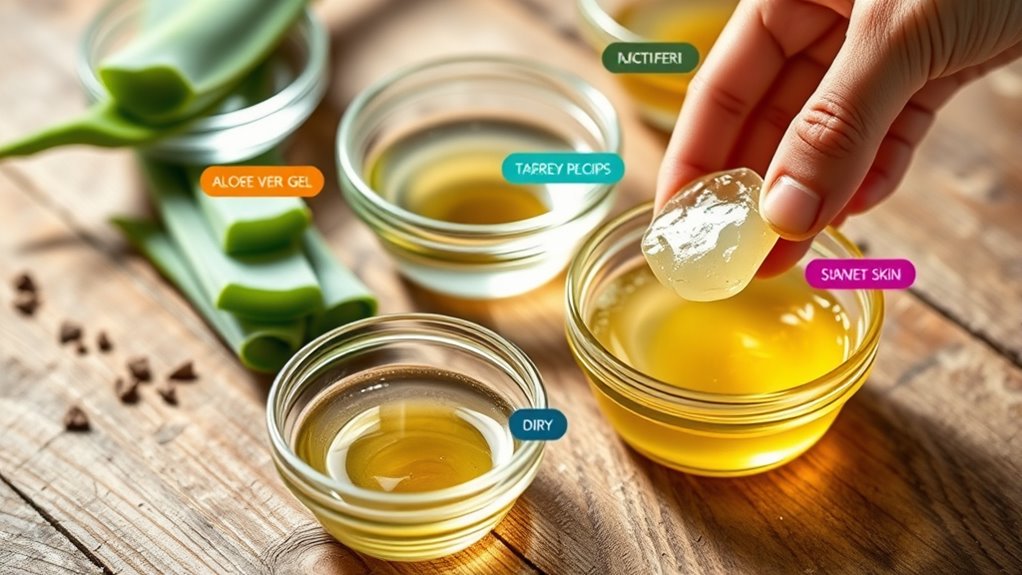
Different skin types respond best to tailored aloe gel recipes that address their unique needs. For sensitive skin, add calming ingredients like chamomile or cucumber extract to reduce irritation. Oily or acne-prone skin benefits from ingredients such as tea tree oil or witch hazel, which help control excess oil. Dry skin needs extra hydration—consider adding honey or glycerin to boost moisture. Customizing your aloe gel ensures you target specific concerns effectively.
Tailor aloe gel with calming, oil-control, or hydrating ingredients to suit your skin’s unique needs.
- Recognize your skin’s unique sensitivities and needs
- Incorporate ingredients that complement your skin type
- Adjust ingredient quantities to avoid irritation or dryness
Frequently Asked Questions
How Long Does Homemade Aloe Vera Gel Last Before Spoiling?
You’re probably wondering how long homemade aloe vera gel stays good before spoiling. Typically, it lasts about 1 to 2 weeks when stored in an airtight container in the refrigerator. To extend its shelf life, consider adding natural preservatives like vitamin C or lemon juice. Always check for signs of spoilage, such as a sour smell or changes in texture, before applying it to your skin.
Can I Add Essential Oils Safely to My Aloe Gel?
Ever wonder if adding essential oils to your aloe gel is safe? You can, but you must be cautious. Essential oils are potent and can cause irritation if not diluted properly. Always do a patch test first, and use only high-quality, skin-safe oils. Follow recommended dilution ratios, typically 1-2 drops per ounce of gel, to enjoy their benefits without risking your skin’s health.
Is There a Risk of Allergic Reactions With Herbal Additives?
You might wonder if adding herbal additives to your aloe gel causes allergic reactions. While many herbs are safe, some people can develop allergies or skin irritation. To minimize risks, perform a patch test before applying the gel broadly. Use fresh, high-quality herbs and monitor your skin’s response. If you notice redness, itching, or swelling, discontinue use immediately. Always consult a healthcare professional if you’re uncertain about specific herbs.
What’S the Best Way to Test My Gel’S Skin Compatibility?
Ah, the classic quest for the perfect skin compatibility test—because who doesn’t love turning their bathroom into a scientific lab? You should patch test your gel by applying a small amount to a discreet skin area, like your inner wrist or behind your ear. Wait 24 hours, watch for redness or irritation, and if all’s clear, you’re good to go. It’s simple, safe, and saves you from potential sunburned regret.
How Often Should I Apply the Aloe Gel After Sun Exposure?
After sun exposure, you should apply aloe gel as needed to soothe and hydrate your skin. Usually, reapply every two to three hours, especially if your skin feels dry or irritated. Listen to your body—if your skin shows signs of redness or discomfort, use the gel more frequently. Consistent application helps reduce inflammation and keeps your skin moisturized, aiding faster recovery.
Conclusion
Now that you’ve crafted your own herbal aloe gel, think of it as a cool, soothing oasis in a desert of sun-exposed skin. With your personalized blend, you’ll nurture your skin back to health, like watering a wilting plant restores its vibrancy. Keep experimenting and adjusting to find your perfect formula. Your post-sun skincare routine just became a revitalizing, natural retreat—ready to revive and calm your skin anytime the sun takes its toll.

